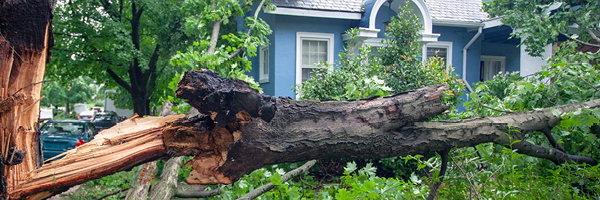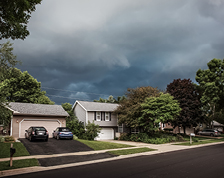Quick guide to protect your home from high winds
Posted in Home

When high winds are blowing through your region, you don’t have much time to act. Here’s how to protect your home and property if a storm is currently threatening your area:
- Secure any objects outside your house that may become flying debris in heavy winds.
- Watch or listen to local weather reports for updates, evacuation orders and shelter information. Evacuate as early as possible, especially if your area is flood-prone.
- If you stay in your house during the storm, find a sheltered area away from doors, windows and any glass items.
- Move your family emergency kit to an accessible area of your home and educate all family members about what’s inside.
- Place any valuables, jewelry and important documents in a safe location.
- If possible, relocate personal belongings and valuables to higher levels. Lower levels will flood first and cause extensive damage.
You may not have time to do everything on this list. Prioritize the safety of you and your loved ones first. If you have time, manage your belongings and get your emergency kit.

Learn about our
Home Insurance
The difference between sustained winds, damaging winds and other classifications
The National Weather Service uses different terminology to help you understand what kind of storm threats are happening. Get familiar with these definitions from the National Oceanic and Atmospheric Administration (NOAA), National Weather Service and the Federal Emergency Management Agency so you’re better prepared for the next storm with high winds:
- Wind gusts—rapid fluctuations in the wind speed with a variation of 10 knots or more between peaks and lulls. The speed of the gust will be the maximum instantaneous wind speed.
- Sustained winds—wind speed determined by averaging observed values over a two-minute period.
- Damaging winds—FEMA calls strong winds damaging winds when they originate from thunderstorms and exceed 58 mph.
- High Wind Warning—sustained, strong winds with even stronger gusts happening. Seek shelter. If you are driving, keep both hands on the steering wheel and slow down.
- High Wind Watch—sustained, strong winds are possible. Secure loose outdoor items and adjust plans as necessary so you’re not caught outside.
- Wind Advisory—Strong winds are occurring but are not strong enough to warrant a High Wind Warning. Objects that are outdoors should be secured and caution should be taken if driving.
What to do after windstorms
Once it’s safe, assess any damage to your home. Walk around the outside of your house and look for:
- Bent, punctured or out-of-place gutters or downspouts.
- Fallen trees around your property.
- Damaged property like a shed, trampoline, patio furniture set, etc.
- Dangling or missing roof shingles. Tip: If you see shingles around your property, be sure to match the shingles to your roof in case they belong to a different nearby property.
If the storm damaged the exterior of your home or exposed any part of the interior, call a professional for help. Your safety is most important, so don’t attempt any potentially dangerous repairs on your own.
How to report a homeowner claim after high winds or damaging winds
Here’s how to file a claim on your homeowners insurance policy after a windstorm:
- Make a list of all the damage to your property.
- Call your Grange Independent Agent to file a claim or report a claim yourself.
- Rest assured, one of our trusted Grange professionals will handle your claim.
Get in touch with a local agent for homeowners insurance
Grange Insurance will help you protect what matters most to you. Talk to a local agent today to learn more about your options for homeowners insurance coverage.
References
Weather.gov Glossary
Weather.gov Safety
Fema.gov
Coverages described herein may not be available in all states. Please contact a local independent Grange agent for complete details on coverages and discounts. If the policy coverage descriptions herein conflict with the language in the policy, the language in the policy applies. The material provided above is for informational, educational, or suggestion purposes and does not imply coverage. WE RESERVE THE RIGHT TO REFUSE TO QUOTE ANY INDIVIDUAL PREMIUM RATE FOR THE INSURANCE HEREIN ADVERTISED. Grange Insurance policies are underwritten by Grange Insurance Company, Trustgard Insurance Company, Grange Indemnity Insurance Company, Grange Insurance Company of Michigan and Grange Property & Casualty Insurance Company*. Not all companies are licensed in all states. *Not licensed in Pennsylvania.
Share via:
Facebook
LinkedIn
Email
Related resources

Posted in General, Home, Business
Whether it’s for your home or small business, an emergency kit can help you stay safe and connected to help in a time of need. Learn how to build a basic disaster kit as well as the right emergency kit for your needs.

Posted in Home
We’re teaching you how to prepare for a thunderstorm in just a few minutes. Get the storm tips you need for learning storm terminology, using technology wisely, stowing your items safely and taking cover.

Posted in Business
Thunderstorm safety is an essential piece to your business disaster preparedness. Use these tips to ensure your business emergency plan includes information for thunderstorms and other severe weather to help reduce business interruptions.